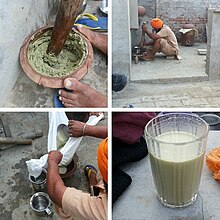
Back ভাং Bengali/Bangla Bhang German Bhang Spanish Bhang Finnish Bhang French भांग Hindi Bhang ID Bhang (gastronomia) Italian バングー Japanese 방 (음식) Korean



| Part of a series on |
| Cannabis |
|---|
 |
Bhang (IAST: Bhāṅg) is an edible preparation made from the leaves of the cannabis plant originating from the Indian subcontinent.[1][2] It has been used in food and drink as early as 1000 BC in ancient India.[3][4] Bhang is traditionally distributed during the spring festival of Maha Shivaratri and Holi.[5][6] Bhang is mainly used in bhang shops, which sell the cannabis-infused Indian drinks bhang lassi and bhang thandai.[7]
- ^ Torkelson, Anthony R. (1996). The Cross Name Index to Medicinal Plants, Vol. IV: Plants in Indian medicine, p. 1674, ISBN 9780849326356, OCLC 34038712. Taylor & Francis. ISBN 9780849326356.
- ^ Helen Schreider; Frank Schreider (October 1960). "From The Hair of Siva". National Geographic. 118 (4): 445–503.
- ^ Staelens, Stefanie (10 March 2015). "The Bhang Lassi Is How Hindus Drink Themselves High for Shiva". Vice.com. Archived from the original on 11 August 2017. Retrieved 10 August 2017.
- ^ Courtwright, David T. (2009). Forces of Habit. Harvard University Press. ISBN 978-0-674029-90-3. Archived from the original on 20 April 2023. Retrieved 16 June 2019.
- ^ "Right kick for day-long masti". The Times of India. 16 March 2014. Archived from the original on 17 April 2019. Retrieved 7 April 2019.
- ^ "Holi 2014: Festival Of Colors Celebrates Spring (SONGS, PHOTOS)". Huffington Post. 16 March 2014. Archived from the original on 17 March 2014. Retrieved 17 March 2014.
- ^ "Thandai in Mumbai: 12 bars in the city to get more bhang for your buck". GQ India. 9 March 2020. Archived from the original on 30 October 2020. Retrieved 5 August 2020.
© MMXXIII Rich X Search. We shall prevail. All rights reserved. Rich X Search